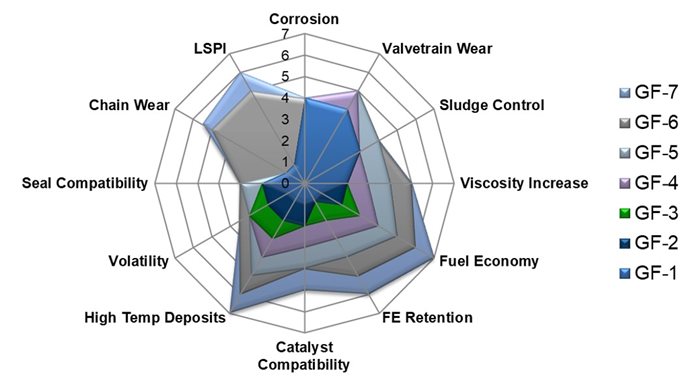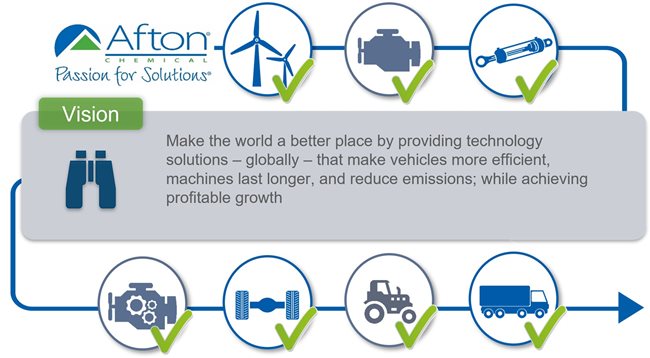Top 7 Questions on ILSAC GF-7
It is essential for the industry to support the OEMs with a meaningful performance upgrade for GF-7 and to finalize and introduce GF-7 as efficiently as possible, providing the OEMs with the maximum potential benefit towards future compliance. Afton are committed to supporting the launch of GF-7 because we believe it is the right approach for OEMs, oil marketers, and additive participants. A robust ILSAC specification is vital for the North American PCMO market.
See below for key questions about GF-7 that Afton addresses to support this industry initiative.
- What are the key benefits of GF-7?
- What other performance benefits are expected to be included in GF-7?
- Why is a first-quarter 2025 launch a good proposal for GF-7?
- What is the process the industry will follow to finalize GF-7?
- How has Afton prepared for GF-7?
- What about GF-8?
- How will Afton meet the demands of GF-7
What are the key benefits of GF-7?
Improved fuel economy and oxidation control
The principal changes in GF-7 are tighter performance demands in Sequence VIE fuel economy and Sequence IIIH oxidation & deposit control. Both changes are designed to help the OEMs meet the challenges of future EPA emissions targets and ensure that engines have minimal energy losses due to viscosity or friction while simultaneously enabling newer engine designs to operate at even greater levels of combustion efficiency and increasing the thermal stress on the oil. Although other industry participants believe these performance targets cannot be adjusted concurrently, a review of previous ILSAC category changes highlighted in the spider chart below indicates that since ILSAC GF-3, fuel economy, and engine oil robustness have consistently increased together.

Expanded pre-ignition protection
In addition to changes in fuel economy and piston cleanliness, the proposed GF-7 specification includes a new variant of the Sequence IX test which evaluates aged-oil pre-ignition protection. The industry has developed this test and is ready for adoption as API SP PLUS. Still, the inclusion in ILSAC GF-7 for 2025 is a more efficient commercial pathway for oil marketers requiring only one change in product licensing and labeling. The proposed limits for the aged oil pre-ignition test are maintained at the current GF-6 Sequence IX level, although significantly superior pre-ignition control is delivered by most market formulations.Improved timing chain wear protection
The final change in engine test performance proposed by the current draft GF-7 proposal is an improvement in timing chain wear protection in the Sequence X test to address field concerns of specific OEMs in select engine designs. This improvement represents a minimal 5% change in wear performance versus GF-6 that is readily achievable.
Improved low-temperature properties and other bench-test changes
[back to top]
What other performance benefits are expected to be included in GF-7?
Added protection for Hybrid engines
At an industry presentation in Detroit in May, Afton proposed to expand the scope of ILSAC GF-7 with a specific definition of performance targets for hybrid engines. Industry stakeholders have highlighted similar concerns for hybrid operation in different industry forums. The hybrid GF-7 specification would align with the proposed OEM limits for GF-7 but also include additional demands for improved low-temperature valve train wear, corrosion protection, emulsion stability, and reduced sulphated ash to address the unique operational demands of a hybrid configuration. Under certain modes of operation, a hybrid might present the engine oil with a more severe operating environment leading to specific performance issues not usually seen in a typical ICE configuration. As these enhancements for hybrid operation would also provide additional performance reliability for ICE engines, the tighter performance targets could be readily included in the base ILSAC GF-7 specification if required by the OEMs.See below to view Afton’s presentation.
[back to top]
Why is a first-quarter 2025 launch a good proposal for GF-7?
The next significant change in EPA emissions targets applies to model year 2025 vehicles. The primary change within the EPA legislative targets is a further reduction in CO2 emissions, which can only be achieved by using less fuel, and this represents a 9% increase in vehicle fleet fuel efficiency for OEMs to target. Further advances beyond 2025 for future model years mean an additional increase of 10% or greater in fuel efficiency. These stringent targets require a range of approaches for the OEMs, including using electric and hybrid designs to reduce fleet fuel consumption. Still, any benefit in engine oil robustness or fuel efficiency that the OEMs could utilize towards these targets in an ICE configuration would be a huge benefit. This is the primary reason behind targeting a first-quarter 2025, first licensing date for GF-7 so that improved technology options could be available to OEMs for vehicle certification.
[back to top]
What is the process the industry will follow to finalize GF-7?
When the OEMs propose a new industry specification, there is a defined period for oil marketers and additive companies to assess capability against the draft specification in what is referred to as a technology demonstration or tech-demo period. Once all parties have had a chance to gauge performance, the proposed limits are reviewed and finalized upon negotiation. A key element in tech-demo is to ensure that the proposed targets are realistic and achievable, such that once the specification is final, after a further period of time defined as the API waiting period, oil marketers and additive companies can efficiently complete their formal qualification programs ahead of first licensing date for the new category.To streamline the market introduction of ILSAC GF-7 and avoid the unnecessary delays of the previous category that are unacceptable to the OEMs, Afton have already completed a GF-7 demonstration program that fully meets all the proposed GF-7 targets. A summary of the Afton GF-7 demonstration program is in the table below, which illustrates that the level of performance the OEMs require for GF-7 is realistic and achievable. In addition, the Afton demonstration program shows that all the performance targets of the initial Afton GF-7 specification proposal and the recent hybrid GF-7 extension can be readily achieved. The demonstration program does not constitute a full product qualification, additional testing would be needed to provide the base oil and viscosity grade coverage of a commercial platform, but this indicates that Afton are ready to move into product qualification and have already completed the tech-demo in support of the OEM proposal for GF-7.
[back to top]
How has Afton prepared for GF-7?
The primary GF-7 initiative for Afton is supporting the OEMs by assisting in future certification testing against EPA legislative requirements to ensure acceptable vehicle reliability under warranty using the ILSAC industry specification. To achieve this, Afton believe that the GF-7 performance upgrade should be meaningful and efficient, and we have focused Afton resources to provide leadership within the industry to deliver this objective. This activity aligns with our corporate vision and is designed to reassure the OEMs that improved lubricant technology can be available to meet their specific needs rather than a compromised alternative.
Secondarily, Afton sees the North American PCMO market facing increasing complexity with the introduction of IFC specifications. Supporting the ILSAC specification benefits the entire industry, and specifications within the industry must be complementary. The development of IFC specifications for application in the North American market is in progress and not currently aligned with GF-7. Still, it would benefit oil marketers and consumers if there was a commonality between the different potential market specifications.
